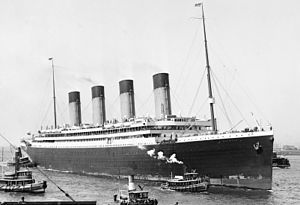RMS Olympic
RMS Olympic was a British ocean liner, sister to the famous ships Titanic and Britannic. Olympic had a career spanning 24 years from 1911 to 1935. In September 1911, Olympic collided with the HMS Hawke. This included service as a troop carrier during World War I, which gained her the nickname "Old Reliable". In September 1915, during World War I, Olympic was painted in a dazzle camouflage, naming itself as the HMT Olympic. On 12 May 1918, she spotted a U-boat ahead, which is named U-103.
 RMS *Olympic* arriving at New York on her maiden voyage, 21 June 1911.
| |
| History | |
|---|---|
| Name | RMS Olympic" |
| Operator |
|
| Port of registry | Liverpool |
| Route | Southampton – Cherbourg – Queenstown – New York City |
| Builder | Harland and Wolff, Belfast |
| Cost | $7.5 million (USD) |
| Yard number | 400 |
| Completed | 31 May 1911 |
| Maiden voyage | 14 June 1911 |
| In service | 1911–1935 |
| Out of service | 12 April 1935 |
| Identification | |
| Fate | Scrapped 1935–37 |
| Notes | Sister to the infamous ships Titanic and Britannic. |
| General characteristics | |
| Class and type | Olympic-class ocean liner |
| Tonnage | 45,324 gross register tons; 46,358 after 1913; 46,439 after 1920 |
| Displacement | 52,067 tons |
| Length | 882 ft 9 in (269.1 m)[1] |
| Beam | 92 ft 9 in (28.3 m) |
| Height | 175 ft (53.4 m) (keel to top of funnels) |
| Draught | 34 ft 7 in (10.5 m) |
| Speed | |
| Capacity | 2,435 passengers |
| Crew | 950 |
Olympic’s port propeller sliced through U-103’s pressure hull. Olympic did not stop to pick up the survivors, but continues on to Cherbourg. She returned to passenger service as RMS Olympic after the war, and served successfully as an ocean liner throughout the 1920s and early 1930s. In May 1934, Olympic struck another ship, called Nantucket Lightship LV-117.
Her scrapping began in 1935 in Jarrow. Between 1935 and 1937, Olympic’s superstructure was demolished, and then, on 19 September 1937, her hull was towed to Thos. W. Ward’s yard at Inverkeithing for final demolition which was completed by late 1937. Olympic was scrapped from 1935 to 1937 due to the Great Depression.
By the time of her retirement, Olympic had completed 257 round trips across the Atlantic, transporting 430,000 passengers on her commercial voyages, travelling 1.8 million miles.
References
change- ↑ Chirnside 2015, p. 34.
- ↑ Chirnside 2015, p. 246.